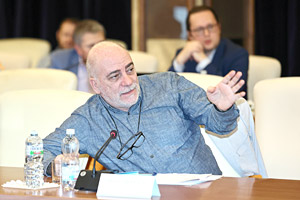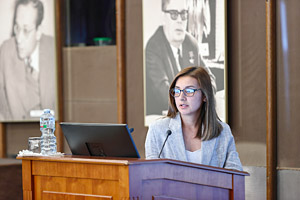
Electronic english version since 2022 |
The newspaper was founded in November 1957
| |
At PAC meetings
Nuclear physics: programme consolidation
On 29-30 June, the 57th meeting of the Programme Advisory Committee on Nuclear Physics was held at the JINR International Conference Hall that concluded the work of the summer programme committees on the main areas of JINR scientific activities.
The meeting was opened by the Chairman of the Committee Valery Nesvizhevsky. JINR Director Grigory Trubnikov delivered a video message to the participants. "Our expert committees bring together representatives from all over the world: from Asia, North America, Latin America, Europe, Africa and we are pleased to see such interest in our scientific programme," he said.
The Chairman of the Committee informed the participants of the meeting about the implementation of the recommendations of the previous meeting of the PAC. JINR Vice-Director Sergey Dmitriev spoke about the resolution of the 133rd session of the Scientific Council (February 2023) and the decisions of the Committee of Plenipotentiaries of the Governments of the JINR Member States (March 2023).

The participants of the event learnt about the reports on the JINR flagship projects and considered proposals for their prolongation. There were reports on new projects and subprojects proposed for opening.
The block of reports included proposals for opening new projects within the framework of the theme "Theory of nuclear systems": "Low-energy nuclear dynamics and properties of nuclear systems" - N.Antonenko, "Microscopic models for exotic nuclei and nuclear astrophysics" - A.Dzhioev, "Quantum systems of several particles" - A.Motovilov, "Relativistic nuclear dynamics and nonlinear quantum processes" - S.Bondarenko.
"The members of the PAC warmly welcomed the projects. We hope that they will be approved and thus our plans for the next five years will be determined," BLTP Deputy Director Nikolay Antonenko commented on the reports. "The project presented in my report concerns both nuclear reactions that are of astrophysical interest and reactions for the production of superheavy nuclei, as well as investigations of the structure of superheavy nuclei. In addition, in recent years, investigations of the manifestations of cluster degrees of free nuclei have attracted great interest, since they can be used to explain phenomena that could not be explained by other methods before," Nikolay Antonenko noted.

Director of the Laboratory of Nuclear Reactions Sergey Sidorchuk proposed prolongation of the theme "Synthesis and properties of superheavy elements, structure of nuclei at the boundaries of nucleon stability". The speaker noted that the JINR Laboratories face the difficult task of long-term planning. In the near future, FLNR is going to divide scientific activity into several themes, each of which will include several projects. "The most important of the projects is work on the synthesis of the 119th and 120th elements. This task is very difficult for many reasons. First, unusual particles - titanium and chromium are accelerated. To do this, it is necessary to provide high intensity. Secondly, very exotic, radioactive Berkelium targets are used that still need to be produced. They are produced by our colleagues from Dimitrovgrad," Sergey Sidorchuk said. He also noted that FLNR plans to explore other ways to "get close" to unknown, unexplored areas of the isotope table.
First of all, it is necessary to modernize the U-400 cyclotron and construct a new experimental hall. FLNR Chief Engineer Igor Kalagin and FLNR Deputy Director Alexander Eremin spoke about the implementation of these tasks. The construction of the new building has already begun and will take three years, after which a practically new facility will be positioned in it by the laboratory team. The experimental base of the Factory of Superheavy Elements currently develops.
A detailed review of the proposed new FLNR project on superheavy nuclei and atoms was presented by the Scientific Secretary of the Laboratory Alexander Karpov. "The project will be mainly carried out at the Factory of Superheavy Elements, the largest infrastructure facility in FLNR. The most important area is, of course, the synthesis of new elements that we hope to start in these five years and get a positive result," he said.
The SHE Factory was put into operation in 2020. Over the past years, two gas-filled recoil separators have been launched: DGFRS-II (Dubna Gas-Filled Recoil Separator) and GRAND. "The results speak for themselves: in terms of the efficiency of our experiments, we have exceeded the capabilities previously provided by the U-400 cyclotron by more than 10 times and we are also ahead of world indicators. Six new isotopes have been obtained and a multiple superiority in the number of obtained atoms has been achieved. All this opens up broad prospects for present and future research.
As Alexander Karpov noted, another important project is the development of instruments for precision measurements of the masses of superheavy elements, the prospects for designing such mass spectrometers were demonstrated under a grant from the Ministry of Education and Science of the Russian Federation in 2020-2022. Among the promising tasks of the laboratory, Alexander Karpov also singled out the investigation of multinucleon transfer reactions that is considered as a technique for obtaining neutron-rich isotopes of transuranium elements.


FLNR Deputy Director Grzegorz Kaminski presented a new project "Light exotic nuclei at the limits of nucleon stability". Over the past five years, significant progress has been made in the investigation of elastic and inelastic scattering in the interactions of helium, lithium and beryllium isotopes and the ACULINA-2 fragment-separator is widely used. The U-400M accelerator is currently modernized and the first experiments with radioactive beams are currently discussed, new techniques are developed for studying reactions with hydrogen isotope targets. A cryogenic tritium target has already been installed for future experiments, the first experiments on it are scheduled for 2025. The plans include the research of the radioactivity of light exotic nuclei, the investigation of the cross section for reactions on deuterium and tritium targets, the cross sections for charge exchange reactions and neutron transfer.
Head of the Department of Nuclear Physics of the Frank Laboratory of Neutron Physics Valery Shvetsov made a proposal to open a new theme "Neutron nuclear physics" and a new project to study the interactions of neutrons with nuclei and the properties of the neutron.

Members of the PAC considered proposals for opening new projects. Ayagoz Baimukhanova presented a project on radiochemistry and spectroscopy for astrophysics and nuclear medicine, Igor Zhitnikov spoke about research on short baseline reactor neutrinos and Evgeny Yakushev invited the PAC members to consider a project on nuclear spectrometry for the search and investigation of rare phenomena.
Reports on the projects and proposals for their prolongation were made by Pavel Zarubin (BECQUEREL-2023), Mihaela Paraipan (E&T&RM with the new name ADSR), Yury Plis ("Investigations of the neutron nuclear interaction and properties of the neutron).
Head of the Baikal-GVD project at JINR Igor Belolaptikov presented to the attention of the committee members a report on the project and a proposal for its prolongation. This major international project is currently implemented by a collaboration of scientists from nine organizations in four countries. As a result of the expedition to Lake Baikal in 2023, the team was able to put into operation two new clusters of the deep-sea neutrino telescope, the total number of which is 12 at present. Each cluster consists of 288 optical modules manufactured at JINR. Today, the facility can capture about 10 neutrinos of galactic and extragalactic origin per year.
Further development of the Baikal-GVD project includes two areas. The first is the development of the concept of a detector with a volume of up to 10 km3 and experimental research of possible solutions for its implementation. The second and main area is the expansion of the operating facility to a volume of 1 km3 with 6000 optical modules. Today, there are 3528 of them. Apparently, by 2026-2028, at the current pace of development, Baikal-GVD will become the largest neutrino telescope in the world.
The programme of the meeting was continued by the meeting of the PAC members with JINR Directorate. Preparation of the recommendations of the PAC and proposals for the agenda of the next meeting of the committee concluded the event.
Based on the information from the JINR Press Office